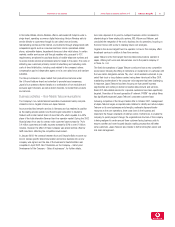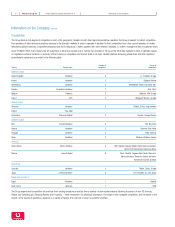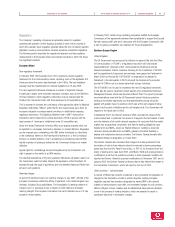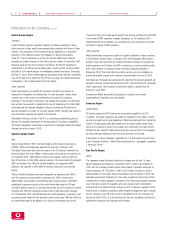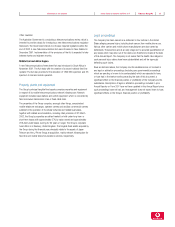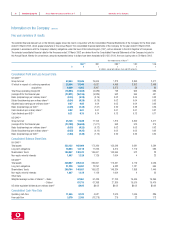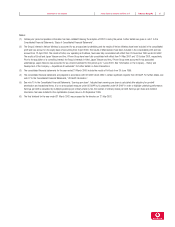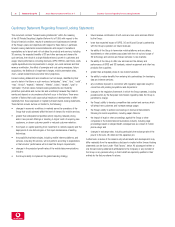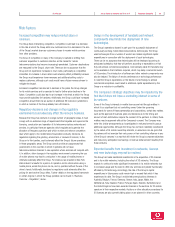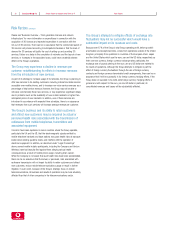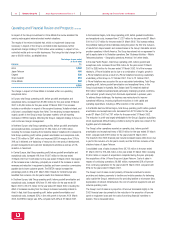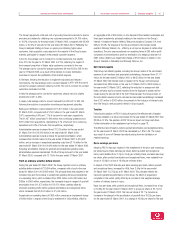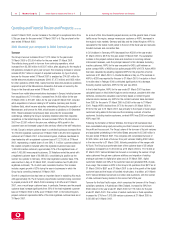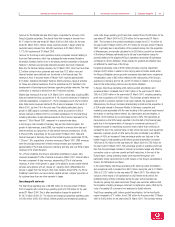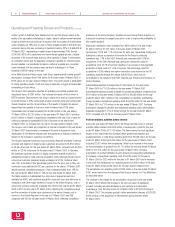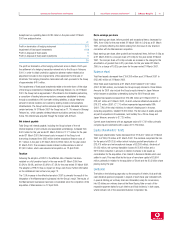Vodafone 2002 Annual Report Download - page 33
Download and view the complete annual report
Please find page 33 of the 2002 Vodafone annual report below. You can navigate through the pages in the report by either clicking on the pages listed below, or by using the keyword search tool below to find specific information within the annual report.
Operating and Financial Review and Prospects Vodafone Group Plc 31Annual Report & Accounts and Form 20-F
Introduction
The following discussion is based on the Consolidated Financial Statements
included elsewhere in this Annual Report. Such Consolidated Financial
Statements are prepared in accordance with Generally Accepted Accounting
Principles in the United Kingdom, or UK GAAP, which differ in certain significant
respects from US GAAP. Reconciliations of the material differences in such
Consolidated Financial Statements to US GAAP are set forth in note 37 to the
Consolidated Financial Statements, “US GAAP information”.
Foreign Currency Translation
The Company publishes its Consolidated Financial Statements in pounds sterling.
In this Annual Report, references to “US dollars”, “$”, “cents” or “¢” are to
United States currency and references to “pounds sterling”, “£”, “pence” or “p”
are to UK currency. References to “euros” or “1”are to the currency of the
European Union, which, prior to 1 January 2002, was used only in “paperless”
transactions. Euro banknotes and coins were issued on 1 January 2002. Merely
for convenience, this Annual Report contains translations of certain pounds
sterling and euro amounts into US dollars at specified rates. These translations
should not be construed as representations that the pounds sterling or euro
amounts actually represent such US dollar amounts or could be converted into
US dollars at the rate indicated or at any other rate. Unless otherwise indicated,
the translations of pounds sterling and euro amounts into US dollars have been
made at $1.4250 per £1.00 and $0.8717 per 11.00, the noon buying rate in
the City of New York for cable transfers in pounds sterling and euro amounts as
certified for customs purposes by the Federal Reserve Bank of New York (the
“Noon Buying Rate”) on 29 March 2002. The Noon Buying Rate on 24 May 2002
was $1.4577 per £1.00 and $0.9220 per 11.00. See “Exchange rate
information“ below for information regarding the Noon Buying Rates for the
financial years ended 31 March 1998 through 31 March 2002, and for the
period from 1 December 2001 to 24 May 2002.
Basis of Segmental Reporting
As described under “Business Overview – Business activities – Mobile
Telecommunications – Geographic operations”, following the reorganisation
of the Group’s overall management structure and geographical division of
operations on 1 April 2001 and 1 January 2002, the Group has adopted the
following segments for the presentation of its geographical analysis of results:
Europe (further sub-analysed between Northern Europe, Central Europe and
Southern Europe); Americas; Asia Pacific; and Middle East and Africa. Analyses
of the Group’s operating results for the twelve months ended 31 March 2001
and 31 March 2000 have been amended and comparatives have been restated.
See note 3 to the Consolidated Financial Statements, “Segmental analysis”,for
further details.
Critical Accounting Policies
The application of UK GAAP often requires judgements by management when
formulating the Group’s accounting policies and presenting a true and fair view
of the Group’s financial position and results in its Consolidated Financial
Statements. Often, judgement is required in respect of items where the choice of
specific policy to be followed can materially affect the reported results or
net asset position of the Group, in particular through estimating either the lives
or recoverability of particular assets, or in the timing of when a transaction
is recognised.
The Company considers the Group’s accounting policies in respect of the
accounting for goodwill and, to a lesser extent, revenue recognition to be
the most critical policies and, accordingly, has provided an explanation of
each below.
Goodwill
Goodwill is calculated as the surplus of cost over fair value attributed to the net
assets (excluding goodwill) of subsidiary undertakings, joint ventures and
associated undertakings acquired.
For acquisitions made before the adoption of FRS 10, “Goodwill and Intangible
Assets”, on 1 April 1998, goodwill was written off directly to reserves. Goodwill
written off directly to reserves is reinstated in the profit and loss account when
the related business is sold. As at 31 March 2002, the total value of goodwill
held in reserves is £1,190 million (2001: £1,193 million).
For acquisitions made after the financial year ended 31 March 1998, goodwill is
capitalised and held as a foreign currency denominated asset, where applicable,
and is thus subject to exchange rate fluctuations. In the event of impairment,
a charge is made to the profit and loss account in the period in which the
impairment occurs, with a corresponding write down in the carrying value
of goodwill.
Once capitalised, goodwill is amortised on a straight-line basis over its estimated
useful economic life. For goodwill related to cellular network businesses this is
the shorter of the unexpired period of the licence under which the network
operator provides telecommunications services or twenty-five years. For other
acquisitions, including customer bases, the amortisation period for goodwill is
typically between five and ten years.
At 31 March 2002, goodwill, including that attributable to the acquisition of
interests in associated undertakings, amounted to £116,665 million, and
represented 72% of the Group’s total assets. As a result, the choice of
amortisation period is critical to the Group’s results. Applying the lives referred
to in the previous paragraph has resulted in this year’s charge for amortisation
amounting to £13,470 million.
Asset recoverability is also an area requiring management judgement, requiring
assessment as to whether the carrying value of assets can be supported by the
net present value of future cash flows derived from assets using cash flow
projections, and discounting using an appropriate rate. The Group has completed
a number of significant acquisitions over the three years ended 31 March 2002,
generating a significant level of goodwill within the Group’s balance sheet.
All goodwill was reviewed for potential impairment as at 31 March 2002 and, as
a result, an impairment charge for the year of £5,100 million was made to the
profit and loss account. Changing the assumptions selected by management to
determine the level if any of impairment, including the discount rates or the
growth rate assumptions in the cash flow projections, could significantly affect
the Group’s results. For further details on the impairment review, see note 14
to the Consolidated Financial Statements, “Impairment”.
Operating and Financial Review and Prospects


